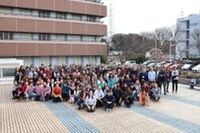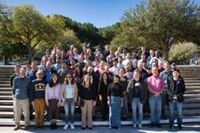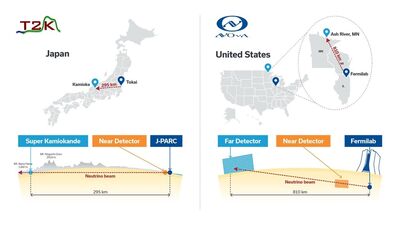"Rival" neutrino experiments NOvA and T2K publish first joint analysis- The combined results add to physicists' understanding and they validate the impressive collaborative effort between two competing - yet complementary - experiments. -
High Energy Accelerator Research Organization
The University of Tokyo
J-PARC Center
The T2K experiment in Japan and the NOvA experiment in the United States conducted a joint analysis and published their first results in the journal Nature. Both are long-baseline neutrino oscillation experiments using accelerators, and by leveraging their different baselines and energy conditions, they achieved precision measurements of neutrino oscillations. As a result, they succeeded in reducing the uncertainty in the differences between neutrino masses to below 2%. Although the ordering of the three neutrino masses is still unknown, their results show that depending on this ordering, the magnitude of CP symmetry violation-a difference in behavior between particles and antiparticles-would be strongly constrained. This achievement marks an important step toward uncovering CP symmetry violation in neutrinos and the origin of the matter-antimatter asymmetry in the universe. The joint analysis combined ten years of T2K data collected since 2010 and six years of NOvA data collected since 2014, and it also demonstrates the strength of collaboration between two international experiments that are competitive yet complementary.
Fig. 1 : T2K in Japan (left) and NOvA in the United States (right) are both long-baseline experiments: they each shoot an intense beam of neutrinos that passes through both a near detector close to the neutrino source and a far detector hundreds of kilometers away. Both experiments compare data recorded in each detector to learn about neutrinos' behavior and properties.
Context
When the universe began, physicists expect there should have been equal amounts of matter and antimatter. But if that were so, the matter and antimatter should have perfectly canceled each other out, resulting in total annihilation.
And yet, here we are. Somehow, matter won out over antimatter - but we still don't know how or why.
Physicists suspect the answer may lie in the mysterious behavior of abundant yet elusive particles called neutrinos. Specifically, learning more about a phenomenon called neutrino oscillation - in which neutrinos change types, or flavors, as they travel - could bring us closer to an answer.
The international collaborations representing two neutrino experiments, T2K in Japan and NOvA in the United States, recently combined forces to produce their first joint results, published today in the journal Nature. This initial joint analysis provides some of the most precise neutrino-oscillation measurements in the field.
"These results are an outcome of a cooperation and mutual understanding of two unique collaborations, both involving many experts in neutrino physics, detection technologies and analysis techniques, working in very different environments, using different methods and tools," says T2K collaborator Tomáš Nosek.
Different experiments, common goals
Despite their ubiquity, neutrinos are very difficult to detect and study. Even though they were first seen in the 1950s, the ghostly particles remain deeply enigmatic. Filling in gaps in our knowledge about neutrinos and their properties may reveal fundamental truths about the universe.
T2K and NOvA are both long-baseline experiments: they each shoot an intense beam of neutrinos that passes through both a near detector close to the neutrino source and a far detector hundreds of miles away. Both experiments compare data recorded in each detector to learn about neutrinos' behavior and properties.
NOvA, the NuMI Off-axis νe Appearance experiment, sends a beam of neutrinos 810 kilometers from its source at the U.S. Department of Energy's Fermi National Accelerator Laboratory near Chicago, Ill., to a 14,000-ton liquid-scintillator detector in Ash River, Minnesota.
The T2K experiment's neutrino beam travels 295 kilometers from Tokai to Kamioka - hence the name T2K. Tokai is home to the Japan Proton Accelerator Research Complex (J-PARC) and Kamioka hosts the Super-Kamiokande neutrino detector, an enormous tank of ultrapure water located a kilometer underground.
Since the experiments have similar science goals but different baselines and different neutrino energies, physicists can learn more by combining their data.
"By making a joint analysis you can get a more precise measurement than each experiment can produce alone," says NOvA collaborator Liudmila Kolupaeva. "As a rule, experiments in high-energy physics have different designs even if they have the same science goal. Joint analyses allow us to use complementary features of these designs."
As long-baseline experiments, NOvA and T2K are ideal for studying neutrino oscillations, a phenomenon that can provide insight into open questions like charge-parity violation and the neutrino mass ordering. Two experiments with different baselines and energies have a better chance of disentangling the two effects than one experiment alone.
Interrogating neutrino oscillations
The mystery of neutrino mass ordering is the question of which neutrino is the lightest. But it isn't as simple as placing particles on a scale. Neutrinos have miniscule masses that are made up of combinations of mass states. There are three neutrino mass states, but, confusingly, they don't map to the three neutrino flavors. In fact, each flavor is made of a mix of the three mass states, and each mass state has a different probability of acting like each flavor of neutrino.
There are two possible mass orderings, called normal or inverted. Under the normal ordering, two of the mass states are relatively light and one is heavy, while the inverted ordering has two heavier mass states and one light.
In the normal ordering, there is an enhanced probability that muon neutrinos will oscillate to electron neutrinos but a lower probability that muon antineutrinos will oscillate to electron antineutrinos. In the inverted ordering, the opposite happens. However, an asymmetry in the neutrinos' and antineutrinos' oscillations could also be explained if neutrinos violate CP symmetry - in other words, if neutrinos don't behave the same as their antimatter counterparts.
The combined results of NOvA and T2K do not favor either mass ordering. If the neutrino mass ordering is found to be normal, NOvA's and T2K's results are less clear on CP symmetry, requiring additional data to clarify. However, if future results show the neutrino mass ordering is inverted, the results published today provide evidence that neutrinos violate CP symmetry, potentially explaining why the universe is dominated by matter instead of antimatter.
"Neutrino physics is a strange field. It is very challenging to isolate effects," says Kendall Mahn, co-spokesperson for T2K. "Combining analyses allows us to isolate one of these effects, and that's progress."
The combined analysis does provide one of the most precise values of the difference in mass between neutrino mass states, a quantity called Δm232. With an uncertainty below 2%, the new value will enable physicists to make precision comparisons with other neutrino experiments to test whether the neutrino oscillation theory is complete.
What's next
These first joint results do not definitively solve any mysteries of neutrinos, but they do add to physicists' knowledge about the particles. Plus, they validate the impressive collaborative effort between two competing - yet complementary - experiments.
The NOvA collaboration consists of more than 250 scientists and engineers from 49 institutions in eight countries. The T2K collaboration has more than 560 members from 75 institutions in 15 countries. The two collaborations began active work on this joint analysis in 2019. It combines 6 years of data from NOvA, which began collecting data in 2014, and a decade of data from T2K, which started up in 2010. Both experiments continue to take data, and efforts are already underway to update the joint analysis with the new data.
"The joint analysis work has benefited both collaborations," says Patricia Vahle, co-spokesperson for NOvA. "We have a much better mutual understanding of the strengths and challenges of the different experimental setups and analysis techniques."
NOvA and T2K are the only currently operating long-baseline neutrino experiments. Their initial combined results lay a foundation for forthcoming neutrino experiments that will answer the questions around neutrinos unambiguously.
The Fermilab led Deep Underground Neutrino Experiment is under construction in Illinois and South Dakota in the U.S. With its longer baseline of 1,300 kilometers, DUNE will be more sensitive to neutrino mass ordering and could give physicists a conclusive answer shortly after it turns on in the early years of the next decade.
In Japan, Hyper-Kamiokande, the successor to Super-Kamiokande, is currently under construction in an underground mine in Kamioka, Hida City, Gifu Prefecture, with experiments scheduled to begin in 2028. Hyper-Kamiokande will conduct highly sensitive searches for CP symmetry violation through high-statistics measurements made possible by a detector about eight times larger and an intense neutrino beam.
Many physicists hope these next-generation neutrino experiments can come together - as NOvA and T2K have already done - to make progress on their shared scientific goals to learn more about neutrinos and their unusual properties.
"As shown in this very analysis, there are no truly 'rivaling' experiments because they all share a common goal of scientific study of a phenomenon," says Nosek. "Collaborating is naturally important for the transfer of knowledge, know-how and experience, and for sharing resources, ideas and tools. The T2K-NOvA collaboration is not merely a sum of T2K and NOvA collaborations. It is much, much more."
 |
 |
Fig. 2: The T2K collaboration (left) and the NOvA collaboration (right).
Publication Details
Authors: S.Abubakar et al. (NOvA and T2K collaboration)
Journal: Nature Vol. 646, pp.818-824, on October 22, 2025
https://www.nature.com/articles/s41586-025-09599-3

